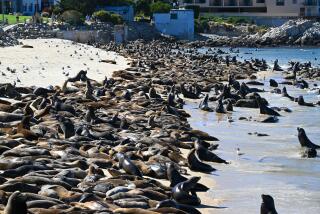Last Stand of the Island Foxes
- Share via
The fox population on islands in the Channel Islands National Park has dropped 90% in six years, scientists said, making the house cat-sized fox one of North America’s most imperiled canines.
Scientists are considering expanding a captive-breeding program on Santa Cruz Island. And last weekend, scientists flew veterinarians to Santa Rosa Island to treat a cancer-stricken female fox who may not have lived through the next breeding cycle.
Because Santa Cruz was a private island for a long time, scientists have little idea how many foxes--which have become easy pickings for recent arrivals of golden eagles--live on the chain’s largest island.
Scientists hope to determine whether they will have to remove foxes from other islands and place them in captivity to save them from extinction.
About 75% of the island is owned by the Nature Conservancy, a nonprofit group dedicated to preserving species and land. In August, the organization donated about 8,500 acres of the rugged island to Channel Islands National Park, and is working with park biologists to track the foxes.
“We don’t know where we stand,” said Lynn Lozier, the conservancy’s Santa Cruz Island project director. “We need to know how many foxes we have, where they are and how close they are to each other.”
Researchers, who began counting the foxes six years ago, expect to find 80 to 150 foxes on Santa Cruz. On Santa Rosa Island, there are 22 in captivity, and maybe as many as five roaming wild. On San Miguel, there’s one fox scientists haven’t been able to track down and 16 in captivity.
On Santa Rosa, the female fox, known to scientists as A-7015, was anesthetized, placed on an outdoor picnic table and treated with laser surgery Saturday to remove a tumor on her palate. The sarcoma tumor, diagnosed about two weeks ago, could still kill her before she breeds, but biologists considered the breeding of new foxes so important they chartered a $1,000 flight to bring out the volunteer doctors.
“The bottom line is we don’t know how much time they bought her. A couple months or half a year?” said Tim Coonan, a park biologist. “Hopefully, she’ll recover and go back to courtship with her male.”
Foxes pair up during a courtship that begins in October, continues with breeding in early March, and ends when a litter is born in mid- to late April. If A-7015 dies, her mate would likely not breed with another female.
She is one of nine females on Santa Rosa to pair up with a male, and she had three pups last year, which Coonan called a good track record.
“When you know the numbers are this low, then every individual is critical,” said Sam Dover, the veterinarian from the Santa Barbara Zoo who performed the surgery.
Cancer is no less common among foxes than among people, Dover said. But, Coonan said, this is the only cancer he’s seen in thousands of island foxes.
The female fox is recuperating in her pen on Santa Rosa Island. Coonan said scientists may have to raise her litter if she doesn’t recover from her illness after their births.
Settlers arrived on the island in the 19th century, and changes they began still threaten the foxes. Sweet-natured and naive, the toy-like foxes have been sheltered so long they aren’t aware they have predators.
Livestock grazing stripped the islands of shrubbery that protected them from predators, such as the golden eagle, which was drawn to the island to prey upon feral pigs. Biologists are trying to remove both nonnative animals.
On Santa Cruz, scientists trap foxes with cat food bait and then track them across the island. Results from the study should be available in midsummer.
The park service is working with the Nature Conservancy to conduct the $50,000 study, paid for by oil company BP Amoco.
More to Read
Sign up for Essential California
The most important California stories and recommendations in your inbox every morning.
You may occasionally receive promotional content from the Los Angeles Times.













